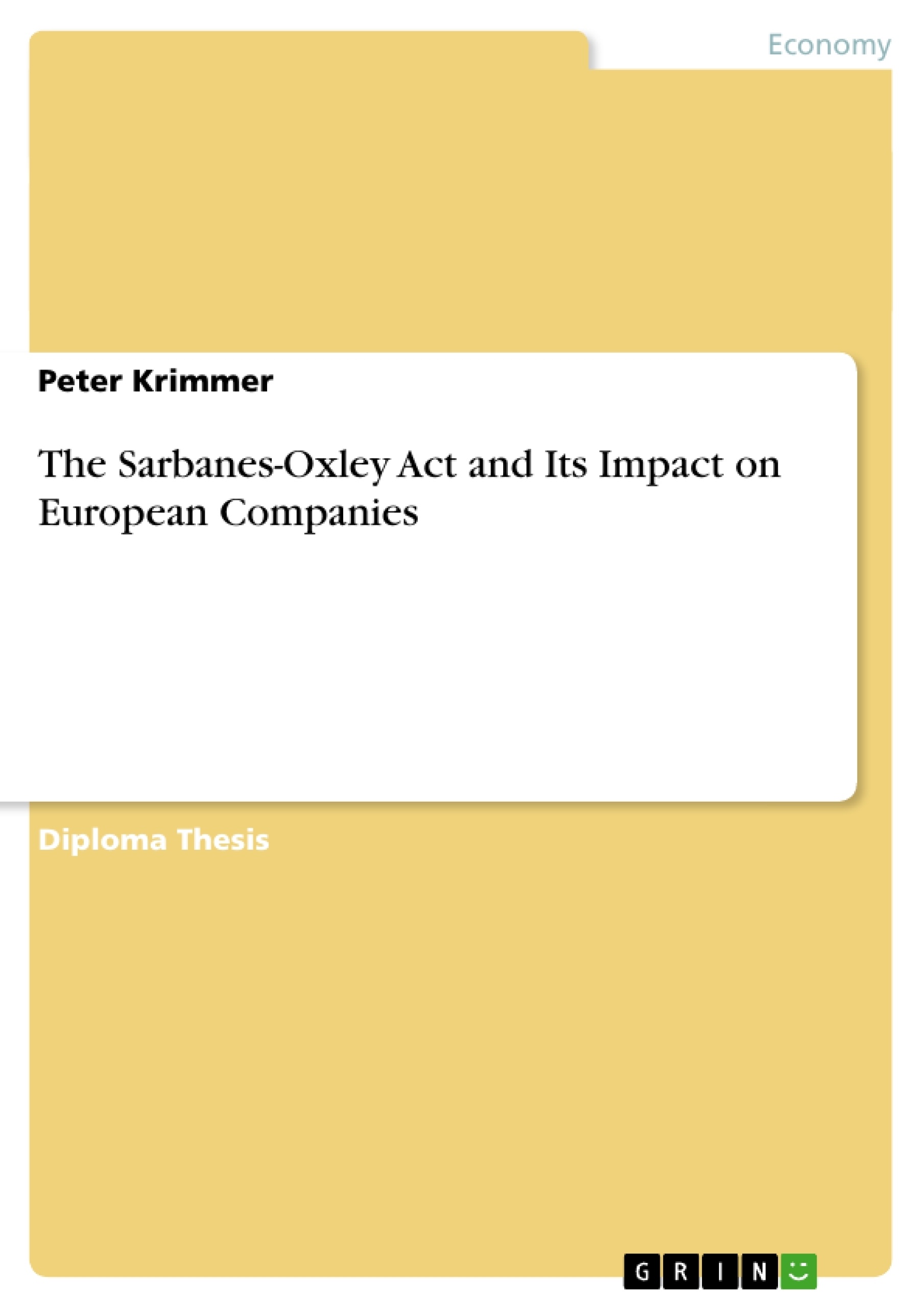The present thesis examines the impact of the Sarbanes-Oxley Act of 2002 (SOA) on European companies and identifies their attitude towards its provisions. To raise the information needed, from May until the end of June 2005 all affected European companies (290) received access to the online questionnaire. Overall nearly twenty percent responded to the questionnaire. The following key findings have been identified:
•The smaller a company is, the more problems it has to comply with the Sarbanes-Oxley Act.
•The degree of the top management’s involvement in the compliance process plays a crucial role.
•Almost every company has a formal code of ethics in place, but their senior management does not communicate it enough to their employees.
•Almost every company has a whistleblower hotline in place to let all employees raise ethics and compliance issues and many of them also indicate that it allows an anonymous, confidential reporting and follow-up on raised issues. Only 30 percent of the hotlines were managed by an outside third party.
•Most of the companies believe that the compliance costs have exceeded the benefits in 2004, but a positive trend - after the first compliance - towards the benefits can be identified.
All in all, the thesis provides a representative overview on the SOA compliance situation of European companies.
Inhaltsverzeichnis (Table of Contents)
- FINANCIAL FRAUDS
- ACKNOWLEDGEMENTS
- TABLE OF CONTENTS
- TABLE OF FIGURES
- ABBREVIATIONS
- ABSTRACT
- INTRODUCTION
- PROBLEM STATEMENT
- HISTORY
- Enron
- WorldCom
- Parmalat
- SUMMARY
- THE SARBANES-OXLEY ACT OF 2002
- CONTENT
- Title I - Public Company Accounting Oversight Board
- Title II - Auditor Independence
- Title III - Corporate Responsibility
- Title IV - Enhanced Financial Disclosures
- Title V - Analyst Conflicts of Interest
- Title VI - Commission Resources and Authority
- Title VII - Studies and Reports
- Title VIII - Corporate and Criminal Fraud Accountability
- Title IX - White-Collar Crime Penalty Enhancements
- Title X- Corporate Tax Returns
- Title XI - Corporate Fraud Accountability
- INTERNAL CONTROL SYSTEM
- Definition
- Objectives
- Committee of Sponsoring Organizations of the Treadway Commission
- SUMMARY
- THE EMPIRICAL SURVEY
- Literature REVIEW
- Sarbanes-Oxley - Beyond Planning
- Sarbanes-Oxley Implementation Survey
- Insights on Today's Sarbanes-Oxley and Corporate Governance Challenges
- Internal Audit - Sarbanes-Oxley Survey
- Business Ethics and Compliance in the Sarbanes-Oxley Era
- Sarbanes-Oxley Compliance Costs Exceed Estimates
- Sarbanes-Oxley Section 404 Work – Looking at the Benefits
- Delisting and Deregistering of German Issuers in the USA
- Summary
- METHODOLOGY
- Research Intention
- Definition of Information Needed
- Implementation of Variables
- Information Collection
- Data Preparation
- Interim Cognition
- Part Company Based Questions
- Part II - Implementation Based Questions
- Part III - Cost Based Questions
- Part IV - Benefits Based Questions
- Cognition Utilization
- SUMMARY
- EXECUTIVE SUMMARY
- The impact of the Sarbanes-Oxley Act on European companies
- Internal control systems and compliance processes
- Implementation challenges, costs, and benefits of SOA compliance
- The implications of SOA for European corporate governance
- A comparative analysis of SOA compliance experiences across different European industries
- The introductory chapter delves into the history of financial fraud, outlining key corporate scandals such as Enron, WorldCom, and Parmalat, which ultimately led to the enactment of the Sarbanes-Oxley Act. It lays the groundwork for understanding the rationale behind the Act's creation and its intended purpose in preventing future financial misconduct.
- Chapter 3 provides a detailed explanation of the Sarbanes-Oxley Act itself, focusing on each of its eleven titles and their corresponding provisions. It explores key areas such as the establishment of the Public Company Accounting Oversight Board, auditor independence, corporate responsibility, enhanced financial disclosures, and the regulation of analyst conflicts of interest. The chapter further examines the concept of internal control systems, outlining their definition, objectives, and the framework established by the Committee of Sponsoring Organizations of the Treadway Commission (COSO).
- Chapter 4 delves into the empirical research methodology used to gather data on the impact of SOA on European companies. It presents a comprehensive literature review summarizing existing research on the implementation and effects of the Act, including perspectives on compliance costs, benefits, and the challenges faced by European firms. The chapter elaborates on the research design, data collection methods, and the questionnaire used to collect insights from European companies regarding their experiences with SOA compliance.
Zielsetzung und Themenschwerpunkte (Objectives and Key Themes)
This thesis investigates the impact of the Sarbanes-Oxley Act (SOA) on European companies, specifically focusing on how the Act's provisions affect the internal control systems and compliance processes of European firms listed on American stock exchanges. The research aims to analyze the implementation challenges, costs, and perceived benefits associated with SOA compliance for European companies, drawing on a comprehensive empirical survey of European businesses.
Zusammenfassung der Kapitel (Chapter Summaries)
Schlüsselwörter (Keywords)
The primary keywords and focus topics of this thesis include Sarbanes-Oxley Act, internal control, compliance, corporate governance, financial reporting, accounting, auditing, European companies, empirical research, and survey methodology. The study examines the practical implications of the SOA for European businesses, delving into their compliance experiences, costs, and perceived benefits. The research aims to provide a comprehensive analysis of the Act's impact on European corporate governance and the challenges faced by companies in navigating the complex regulatory landscape.
- Quote paper
- Mag. Peter Krimmer (Author), 2005, The Sarbanes-Oxley Act and Its Impact on European Companies, Munich, GRIN Verlag, https://www.grin.com/document/48800



